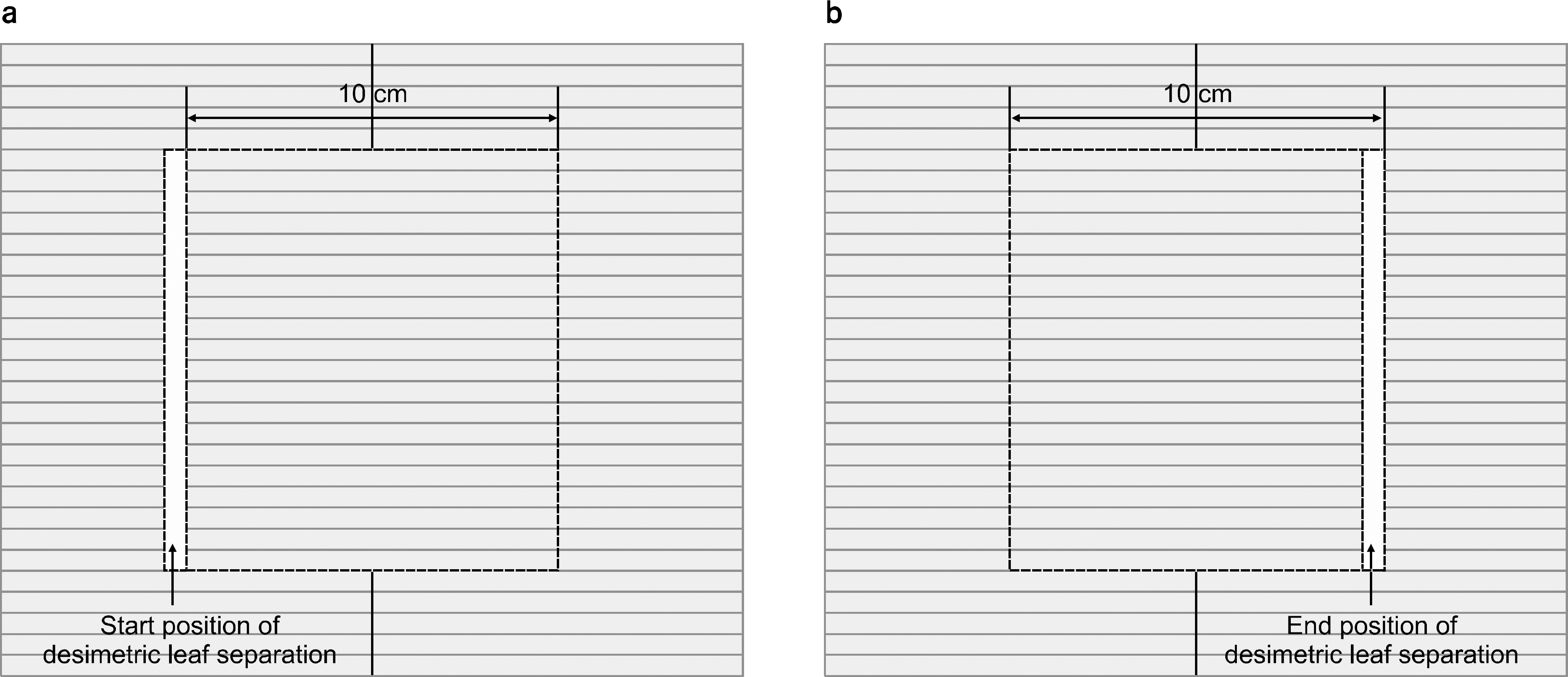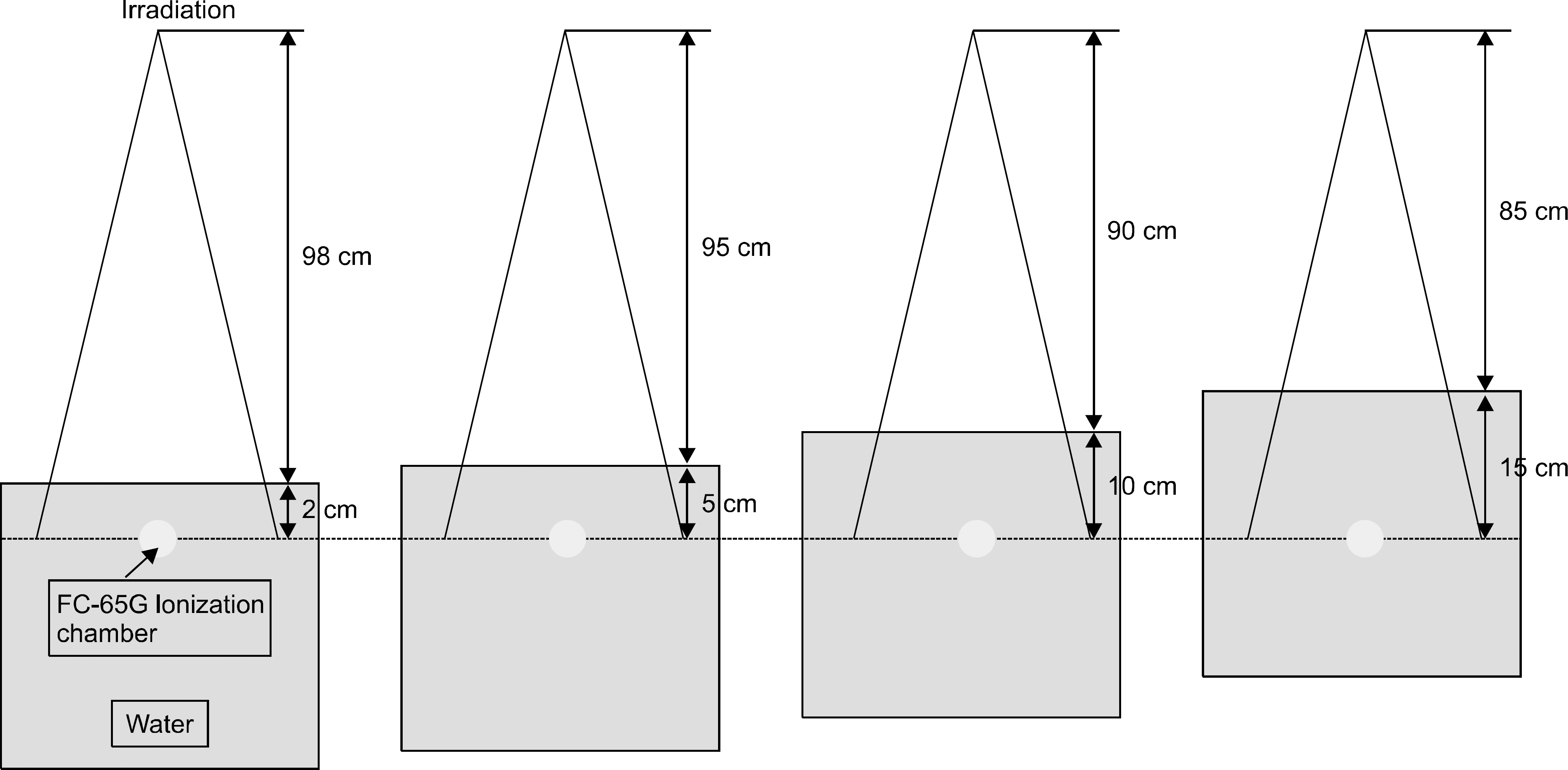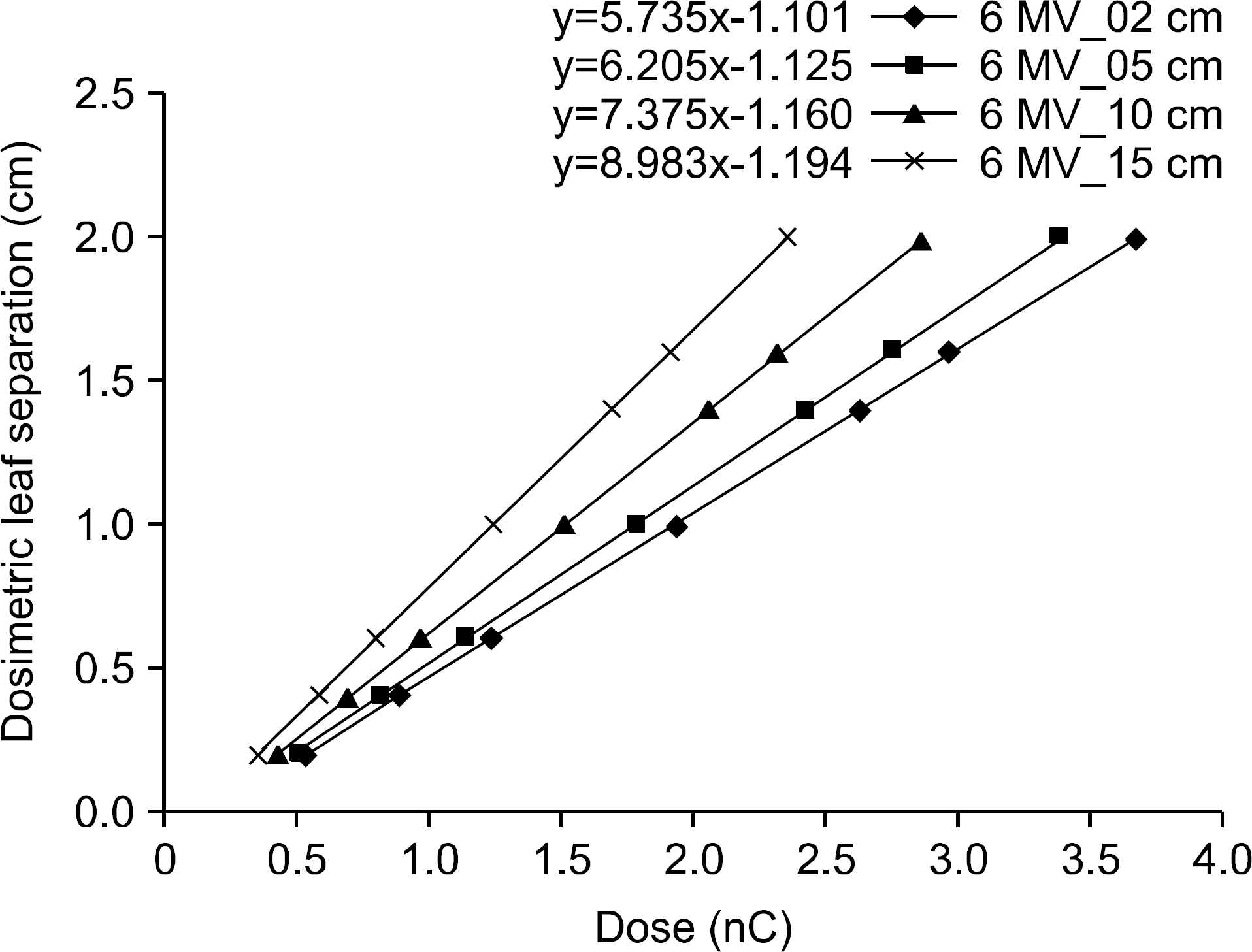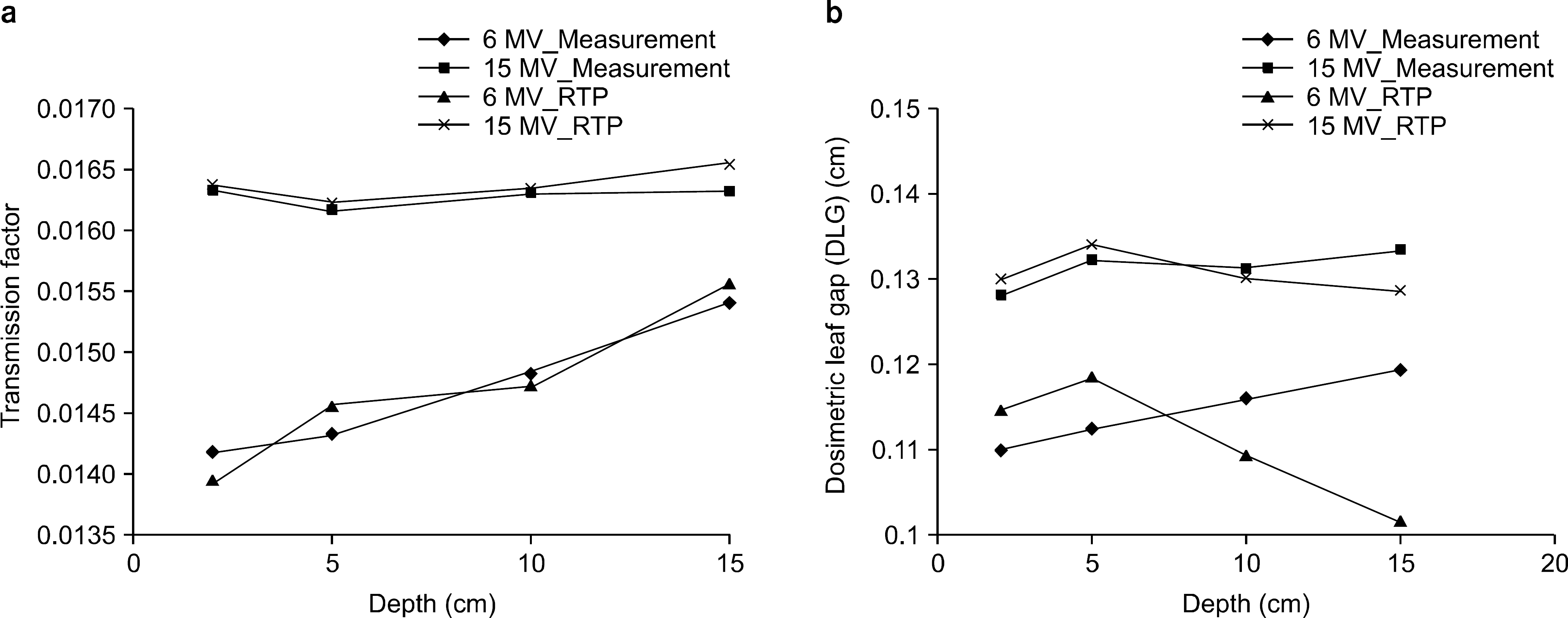Abstract
This study is to evaluate thedosiemtric leaf gap (DLG) at different depths for dynamic intensity-modulated radiation therapy (IMRT) in order to evaluate the absolute dose and dose distribution according to the different positions of tumors and compare the measured and planned the multileaf collimator (MLC) transmission factor (T.F.) and DLG values. We used the 6 MV and 15 MV photon beam from linear accelerator with a Millenium 120 MLC system. After the import the DICOM RT files, we measured the absolute dose at different depths (2 cm, 5 cm, 10 cm, and 15 cm) to calculate the MLC T. F. and DLG. For 6 MV photon beam, the measured both MLC T. F. and DLG were increased with the increase the measured depths. When applying to treatment planning systemas fixed transmission factor with its value measured under the reference condition at depth of 5 cm, although the difference fixed and varied transmission factor is not significant, the dosiemtric effect could be presented according to the depth that the tumor is placed. Therefore, we are planning to investigate the treatment planning system whichthe T. F. and DLG factor according to at the different depths can be applied in the patient-specific treatment plan.
Go to : 
References
1. Otto K. Volumetric modulated arc therapy: IMRT in a single gantry arc. Med Phys. 35:310–317. 2008.

2. Xing L, Thorndyke B, Schreibmann E, Yang Y, Li TF, Kim GY, Luxton G, Koong A. Overview of imageguided radiation therapy. Med Dosim. 31:91–112. 2006.

3. Yoon SM, Lim YS, Park MJ, et al. Stereotactic body radiation therapy as an alternative treatment for small hepatocellular carcinoma. PLoS One. 8:e79854. 2013.

4. Kantz S, Söhn M, Troeller A, et al. Impact of MLC properties and IMRT technique in meningioma and head-and-neck treatments. RadiatOncol. 10:184. 2015.

5. Yu CX1. Li XA, Ma L, et al. Clinical implementation of in tensity-modulated arc therapy. Int J RadiatOncolBiol Phys. 53:453–63. 2002.
6. Huq MS, Das IJ, Steinberg T, Galvin JM. A dosimetric comparison of various multileaf collimators. Phys Med Biol. 47:N159–70. 2002.

7. Williams MJ, Metcalfe P. Verification of a rounded leaf-end MLC model used in a radiotherapy treatment planning system. Phys Med Biol. 51:N65–78. 2006.

8. Mohan R, Jayesh K, Joshi RC, et al. Dosimetric evaluation of 120-leaf multileaf collimator in a Varian linear accelerator with 6-MV and 18-MV photon beams. J Med Phys. 33:114–8. 2008.

9. Wu QJ, Wang Z, Kirkpatrick JP, et al. Impact of collimator leaf width and treatment technique on stereotactic radiosurgery and radiotherapy plans for intra-and extracranial lesions. RadiatOncol. 21:4. 2009.
10. Hong CS, Ju SG, Kim M, et al. Dosimetric effects of multileaf collimator leaf width on intensitymodulated radiotherapy for head and neck cancer. Med Phys. 41:021712. 2014.

11. Sharma DS, Dongre PM, Mhatre V, Heigrujam M. Physical and dosimetric characteristic of high-definition multileaf collimator (HDMLC) for SRS and IMRT. J ApplClin Med Phys. 12:3475. 2011.

12. LoSasso T, Chui CS, Ling CC. Physical and dosimetric aspects of a multileaf collimation system used in the dynamic mode for implementing intensity modulated radiotherapy. Med Phys. 25:1919–27. 1999.

13. Wijesooriya K, Bartee C, Siebers JV, et al. Determination of maximum leaf velocity and acceleration of a dynamic multileaf collimator: implications for 4D radiotherapy. Med Phys. 32:932–41. 2005.

14. Shang Q, Qi P, Ferjani S, Xia P. Effect of MLC leaf width on treatment adaptation and accuracy for concurrent irradiation of prostate and pelvic lymph nodes. Med Phys. 40:061701. 2013.

15. Kumaraswamy LK, Schmitt JD, Bailey DW, et al. Spatial variation of dosimetric leaf gap and its impact on dose delivery. Med Phys. 41:111711. 2014.

16. Kielar KN, Mok E, Hsu A, Wang L, Luxton G. Verification of dosimetric accuracy on the TrueBeamSTx: rounded leaf effect of the high definition MLC. Med Phys. 39:6360–71. 2012.
17. Yao W, Farr JB. Determining the optimal dosimetric leaf gap setting for rounded leaf-end multileaf collimator systems by simple test fields. J ApplClin Med Phys. 16(4):5321. 2015.

18. Lee JW, Choi KS, Hong S, et al. Effects of static dosimetric leaf gap on MLC-based small-beam dose distribution for intensitymodulated radiosurgery. J ApplClin Med Phys. 8:2397. 2007.
19. Mei X, Nygren I, Villarreal-Barajas JE. On the use of the MLC dosimetric leaf gap as a quality control tool for accurate dynamic IMRT delivery. Med Phys. 38:2246–55. 2011.

20. Szpala S, Cao F, Kohli K. On using the dosimetric leaf gap to model the rounded leaf ends in VMAT/RapidArc plans. J ApplClin Med Phys. 15:4484. 2014.

21. Wasb⊘ E, Valen H. Dosimetric discrepancies caused by differing MLC parameters for dynamic IMRT. Phys Med Biol. 53(2):405–15. 2008.
Go to : 
 | Fig. 1.Start (a) and end (b) positions of the 10 mm sliding slit movementfor dosimetric leaf separation file. |
 | Fig. 2.Schematic diagram for calculating of DLG under various depths and source-surface distances. |
 | Fig. 3.An example of linear extrapolation for derivation of a DLG at different depths (2 cm, 5 cm, 10 cm, 15 cm) for 6 MV photon beam. |
 | Fig. 4.Measured and planned transmission factor (a) and dosimetric leaf gap (b) at different depths for 6 MV and 15 MV photon beam. |
Table 1.
Comparison of measured and planned transmission factor at different depths for 6 MV and 15 MV photon beam.
Table 2.
Comparison of measured and planned dosimetric leaf gap (DLG) at different depths for 6 MV and 15 MV photon beam.




 PDF
PDF ePub
ePub Citation
Citation Print
Print


 XML Download
XML Download